USD: Debt ceiling fears ease helping reduce Fed easing expectations
The dollar has made gains against most G10 currencies, supported by a broader improvement in risk sentiment that has reduced expectations of monetary easing.
As monetary easing was already priced in at an early stage, an enhancement in risk can contribute to the dollar’s strength. When the improved risk originates from US-specific factors, it becomes an even more compelling catalyst for the dollar. In this case, the source of optimism lies in the potential for a debt ceiling deal to be reached soon after President Biden’s return from the G7 summit in Japan. Both Biden and Kevin McCarthy’s statements indicate progress, with McCarthy’s remark about a possible deal by the end of the week serving as a significant boost to sentiment.
Stronger retail sales have also played a role, although the data doesn’t significantly alter my outlook. Additionally, the rhetoric from Fed officials expressing concerns about the inflation threat has had an impact.
While it remains uncertain whether the Fed will raise interest rates again, the risk bias continues to lean in that direction.
However, in the absence of any market turbulence, it becomes increasingly difficult to envision monetary easing by December.
As mentioned previously, it is not surprising to see USD/JPY as the most affected currency in the event of debt ceiling-related turmoil. In line with this expectation, it has experienced the largest upward movement among G10 currencies.
USD/JPY may gain further momentum due to potential yen selling flows related to increased hedging activities. The Japanese equity markets are performing exceptionally well and outpacing broader markets. The TOPIX index, both in local currency and USD terms, is reaching new highs not seen since the bursting of Japan’s asset bubble in 1990.
Over the past three months, the TOPIX has risen by 8.3% in local currency and 5.8% in USD terms, compared to a 2.0% gain in the S&P 500.
I have previously highlighted the record-breaking purchases of Japanese equities by foreign investors in recent FX Weekly publications. According to the weekly data released today by the Ministry of Finance, foreign investors bought JPY 808 billion worth of Japanese equities last week, marking the seventh consecutive week of buying.
Warren Buffett’s recent investments in Japan seem to have attracted fresh flows into Japanese equities.
However, asset managers and existing investors may also have seen growth in their equity portfolios, leading to increased yen selling for hedging purposes. It is often noted that yen weakness drives equity market gains, but the correlation can also reflect causality in the opposite direction.
JPY: Falling energy prices reflected in trade data
While the factors mentioned above highlight the positive momentum for USD/JPY, I remain sceptical about the sustainability of yen weakness. The dynamics that led to yen depreciation in 2022 are undergoing changes, indicating that the upside potential will be significantly limited in the future.
One of the changes I have emphasized is the shift in the energy markets, where the substantial negative energy terms of trade shock is beginning to reverse. The Ministry of Finance (MoF) released April trade data yesterday, revealing that Japan’s trade deficit continued to shrink, aided by falling energy prices. The year-on-year change in total imports dropped by 2.3% in April, marking the first decline since January 2021. Over a six-month period, total imports have experienced an annual decrease of 53.6%. The trade deficit reduction was further supported by a 2.6% increase in exports.
Japan’s energy import expenses are now declining rapidly, with the annual change reaching -17.7% in April. This contributed to a 5.0 percentage point decline in overall imports. The proportion of energy to total imports decreased to 24% in April.
In the calendar year 2022, energy imports were 97% higher year-on-year and accounted for 28.5% of total imports. The fuel import bill in April amounted to JPY 2,094 billion, down from the peak of JPY 3,423 billion in August of the previous year. Although the energy deficit remains significant on an annual basis, standing at JPY 32.5 trillion, it marginally decreased for the first time in April since the energy price shock unfolded in 2021.
Naturally, these underlying changes for the yen will take a back seat to rate expectations in the US, which currently drive the upward movement in USD/JPY.
However, they will potentially provide impetus in the opposite direction when the momentum in US rates inevitably fades in the future.
**********









